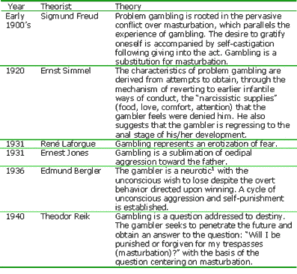The WAGER Vol. 7(13) – Early Contributions to Gambling Research: Psychoanalytic Perspectives on Pathological Gambling
Although the scientific study of pathological gambling has had a relatively brief history, a look back through the literature can be fun and can show just how far we’ve come in our understanding of this important public health issue. Some of the earliest theories were psychoanalytic in approach. Commonly referred to as the father of psychoanalysis, Sigmund Freud has made a lasting impact on our understanding of the human mind. Freud theorized that unconscious mental phenomena play an integral role in both our normal and abnormal psychological activity (AROPA, 2002). His psychoanalytic theories offer a way of understanding human behavior as an interaction between the unconscious and conscious. This WAGER summarizes an article written by Robert M. Lindner in 1950, which presents some early 20th century psychoanalytic theories applicable to problem gambling.
Lindner reported that prior to the 20th century there was virtually no scientific research on the topic of problem gambling. After the turn of the century, however, several psychoanalysts offered theories of the roots of problem gambling. Table 1 reports Lindner’s review of the theories offered by six prominent theorists of the early 20th century.
Table 1: Early psychoanalytic theories of problem gambling identified by Lindner (1)
These psychoanalytic theories demonstrate how much our understanding of pathological gambling has changed over time. Although it might seem strange to suggest that gambling is a substitution for masturbation, the basis of this theory of behavioral substitution resonates with a more modern theory of addictions sometimes called the self-medication hypothesis. Also based in psychoanalytic theory, the self-medication hypothesis proposes that drug and alcohol addictions can substitute for defective or nonexistent ego mechanisms of defense (Khantzian & Shaffer, 1981). Although vastly different in terms of the object being replaced (i.e. masturbation or absence of self-defense mechanism), these two theories both rest on a common psychoanalytic foundation. Through investigating what could be termed “outdated” theories, it is possible to understand how contemporary thought has been shaped over time and has been influenced by early contributions to gambling research.
Comments on this article can be addressed to Debi LaPlante.
Notes
1. The summaries provided in Table 1 are paraphrased from Lindner (1950).
2. A neurosis is a psychic disease frequently occurring, that can be cured by means of psychoanalytical methods. Unlike the case of the individual suffering from psychosis, the neurotic person is conscious of his disease, is socially integrated and able to work and have affective and intellectual satisfactions. A neurotic is someone who suffers from a neurosis (AROPA, 2002).
References
AROPA. (2002). Psychoanalysis: An Online Resource for Home Study and Practice. AROPA. Retrieved, from the World Wide Web: www.freudfile.org
Khantzian, E., & Shaffer, H. (1981). A contemporary psychoanalytic view of addiction theory and treatment. In J. Lowinson & P. Ruiz (Eds.), Substance Abuse in the United States: Problems and Perspectives. Baltimore: Williams and Wikins.
Lindner, R. M. (1950). The psychodynamics of gambling. Annals of the American Academy of Political and Social Science, 269, 93-107.
